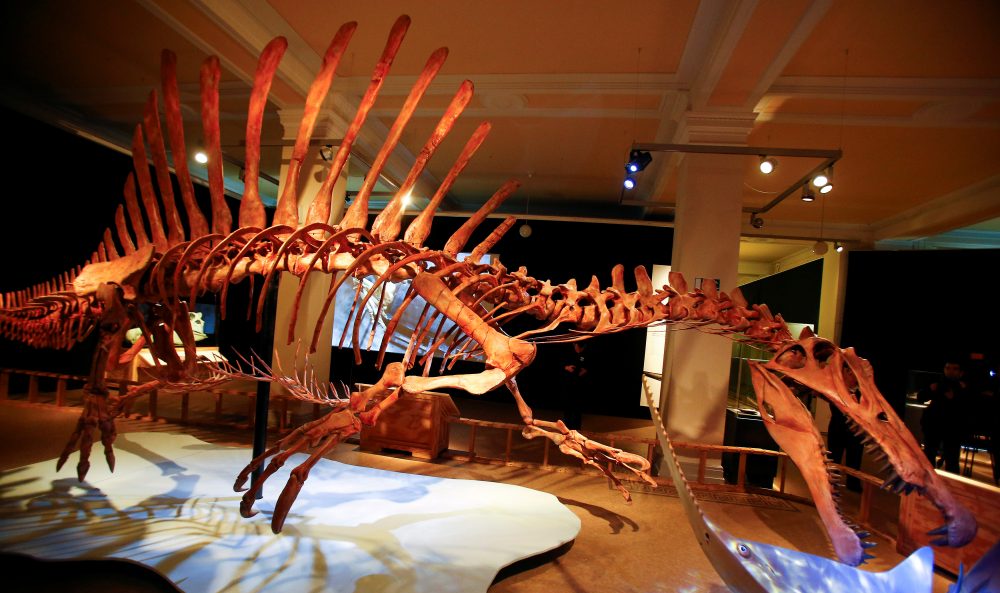One of the biggest, meanest dinosaurs to ever walk the earth was also a swimming terror in the freshwater rivers of prehistoric Africa, according to new research based on a spinosaurus tail fossil.

The spinosaurus had the ferocity of a T. Rex and the swimming skills of a crocodile, even though it was an ancient ancestor to modern-day birds, according to the study published in the journal Nature.
“This discovery overturns decades-old ideas that non-bird dinosaurs were restricted to terrestrial environments,” said co-author Stephanie Pierce, a vertebrae paleontologist and biomechanist at Harvard University.
“So yes, we believe that this discovery does indeed revolutionize our understanding of dinosaur biology.”
The hulking predator had a big, flexible fan on its back, weighed a whopping seven tons and measured about 15 metres (50 feet) from the tip of its tail to the end of its long, narrow, tooth-filled head — a head adapted for breathing just above the surface of a lake or river.
The spinosaurus is perhaps best known in pop culture as the main monster in Jurassic Park III, although that portrayal was based largely on unconfirmed theories at the time that it could swim (and beat a T. Rex in a fight).
The swimming theory has now been proven correct, according to the new research paper.

Get breaking National news
Spinosaurus was a “river monster” with a paddle-like tail and an appetite for large fish, lead study author Nizar Ibrahim told Reuters.
“Spinosaurus had a highly specialized tail — a propulsive structure that would have allowed this river monster to actively pursue prey in the water column,” said Ibrahim, a paleontologist and anatomist at the University of Detroit Mercy.
It’s not the first time Ibrahim has argued that spinosaurus could swim, but he says this new evidence sheds more light on exactly how the big-toothed baddie dominated on land and in the water.
Spinosaurus lived about 95 million years ago during the Cretaceous period, when it would have made a modern-day crocodile (or human) look like a chew toy by comparison.
“It had so many adaptations to an aquatic existence,” said David Martill, a study co-author and paleontologist at the University of Portsmouth.
He listed several water-dwelling features of the dinosaur, including: “nostrils high on the skull and further back from the tip, flat bottomed toe-bones and claws, dense and thickened bone for buoyancy control, and this newly discovered tail form.”
“It would have been at least as aquatic as Nile crocodiles,” Martill told Reuters.
Researchers created plastic models of the tail and attached it to a robot to test its swimming skills, according to study co-author George Lauder, a fish biologist and biomechanist at Harvard University.
Lauder says spinosaurus used to swim like a crocodile, swishing its tail laterally to propel itself through the water.
Archeologists have known about spinosaurus for decades, but their research has been painfully slow because many of the most important fossils were destroyed during the Second World War.
Spinosaurus research got a shot in the arm when a new skeleton was unearthed in Morocco in 2008. Ibrahim and his team published evidence of the dinosaur’s swimming skills in 2014, although some archeologists weren’t convinced.
The latest discovery is based on additional fossils unearthed since 2015 — long after Jurassic Park III ran with the idea that it could swim.
The research team did not offer their direct opinions on how spinosaurus was portrayed in the film, but Pierce did offer her opinion on the “spinosaurus vs. T. Rex” debate.
“It just might topple T. Rex as the most famous and exciting meat-eating dinosaur,” she said.
—With files from Reuters









Comments